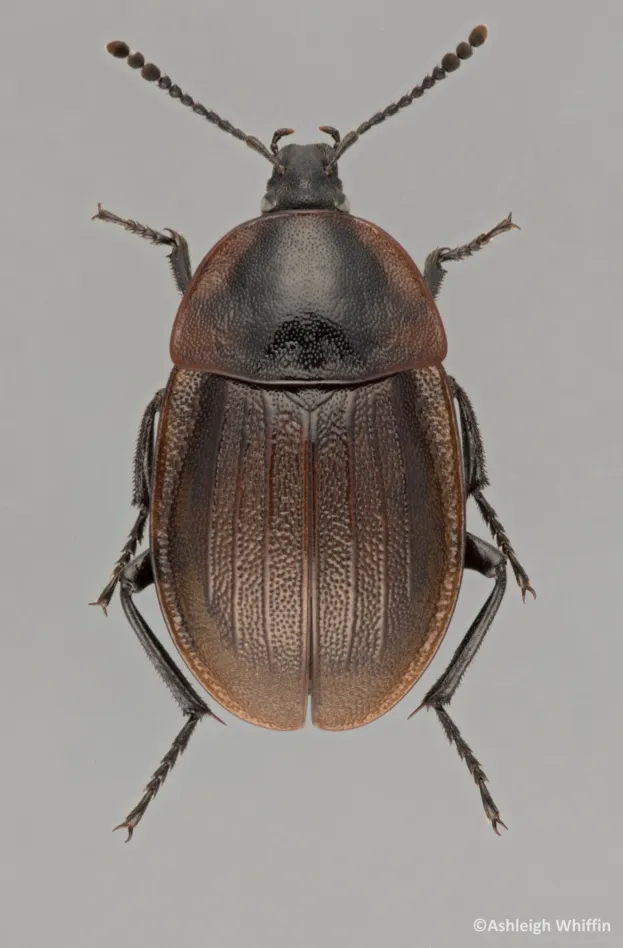The Silphid beetles (family: Silphidae) are a very interesting group of insects, many of them associated with carrion which mean they also important decomposers/recyclers.
Species in genus Nicrophorus, commonly referred to as burying beetles or sexton beetles, are well known for their habits of burying small vertebrate carcasses. This group also display bi-parental care, a rare trait among beetles and for this reason are increasingly being used in behavioural research.
Other species will feed and breed on carrion but do not care for their young. There are a few members of this group that are not associated with carrion, some are herbivores and a couple are even predatory!
There are only 21 species recorded from the UK and most of these are reasonably large in size, making identification a little bit easier than some other groups of beetles.
The National Silphidae Recording Scheme collates records for this group of beetles. You can find out more about the scheme and how to recognise the rest of these fascinating beetles on the recording scheme website.
Here are eight of our British species which are easy to recognise in the field:
Nicrophorus humator (18 - 26 mm)

All seven of the Nicrophorus can be easily recognised as they are reasonably large, chunky beetles, with large eyes, clubbed antenna and truncated wing cases (elytra).
Nicrophorus humator is the largest of our burying beetles and the only resident British species with entirely black elytra. It's one of the commonest species, recorded throughout the UK. It is also attracted to light, so regularly turns up in moth traps.
Nicrophorus vespilloides (10 - 18 mm)

Can be separated from all other British species just by the colour of the antennae, the club is entirely black (orange in all other species). The commonest of the orange and black burying beetles, found throughout the UK. Attracted to light.
Nicrophorus investigator (12 - 22 mm)

Similar to the previous species, but with orange antennal clubs. The pronotum is hairless, hind legs are straight, anterior orange markings on elytra usually more or less continuous across the suture (but not always), with fine golden hairs at the tip of the abdomen only. A common and widespread species in the UK. Attracted to light.
Necrodes littoralis (15 - 25 mm)

This species is another one regularly recorded at light. It is entirely black apart from the very tips of the antenna which are orange. The key difference between this beetle and Nicrophorus humator its antenna are not clubbed. Unlike the burying beetles, this species breeds on carrion in situ (no concealment of the food resource) and the parents do not provide care for the young. It was previously thought to be more common near the coast, but there appears to be little evidence for this and is regularly recorded inland.
Oiceoptoma thoracicum (11 - 16 mm)

Very easy to recognise from the colour pattern (black elytra and striking orange pronotum), and commonly referred to as the Red-breasted Carrion beetle. It’s a bit more of a generalist, found on carrion, fungi and dung. Believed to have a particular association with the stinkhorn fungus Phallus impudicus. Can be found throughout Britain.
Thanatophilus rugosus (8 - 12 mm)

There are 3 species of Thanatophilus – all similar in size and shape. Thanatophilus rugosus is the easiest to recognise. It can be distinguished by the rough texture of the elytra (specifically the bumps between the ridges on the wing cases). Like Necrodes littoralis, it breeds on carrion in situ. The larvae are self-sufficient and sometimes found in large numbers.
Silpha atrata (10 - 15 mm)

This species is a specialised predator of snails. It is found in two colour forms; black (above) and red (below). The black variety is commoner. Both are hairless and shiny in appearance, with an elongate head and mandibles - an adaptation to reach inside the shells of snails.
Their attack method also involves the release of digestive enzymes to dissolve the mucus and flesh of the snail. This predator is common and widespread throughout the UK, especially in wooded areas.

Dendroxena quadrimaculata (12 - 14 mm)

Like Silpha atrata, this species is predatory. It’s predominantly found in woodlands, on oak trees where it hunts caterpillars. With its orangey brown elytra marked with four black spots, it’s a very distinctive beetle, not easily confused with any other British species.